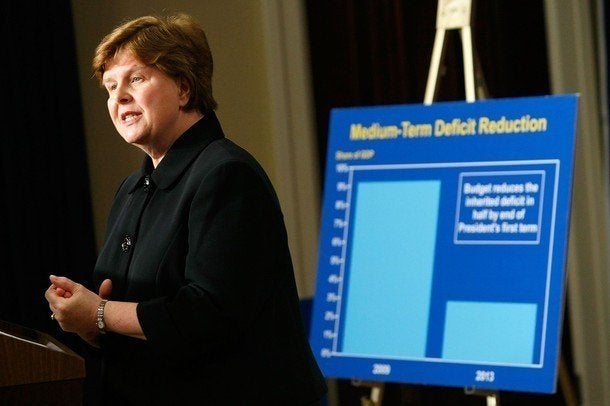
Christina Romer, at a speech at the Brookings Institution Monday afternoon, appeared to give support to critics of Treasury Secretary Timothy Geithner who say that he is wrongly treating the economic collapse as a "liquidity crisis" when it is instead a crisis of solvency in the banking system brought on by a collapse in asset prices.
"Most obviously, like the Great Depression, today's downturn had its fundamental cause in the decline in asset prices and the failure or near-failure of financial institutions," she said in prepared remarks, where she compared and contrasted the current crisis with the Great Depression. The assets in question are, by and large, houses and other real estate.
Asked by the Huffington Post if she specifically disagrees with Geithner as to whether the nation faces a liquidity crisis, however, she said that she does not.
"Let me be very clear. No, I absolutely don't disagree with him," said Romer, head of the president's Council of Economic Advisers. Treasury spokeswoman Stephanie Cutter also said that there was "no contradiction" between the two economic officials' views.
It's more than just an academic question. The administration can't fix the economy if it can't accurately diagnose the problem. But if Romer did say publicly, in an explicit way, that the banking system faced a solvency crisis, that statement in itself could cause chaos in the markets as was seen on a smaller level when Sens. Chris Dodd (D-Conn.) and Charles Schumer (D-N.Y.) said they were open to nationalizing insolvent banks, causing CitiGroup and other bank stocks to dive.
Critics of Geithner, including Nobel Prize winning economist Paul Krugman, insist that the real problem is an asset collapse that led to a crisis of solvency in the banking system. In other words, Krugman argues that home values have come back to Earth, while Geithner hopes to solve the problem by pushing home values back to where they were. The conflict is a serious one because it dictates what response is appropriate.
Geithner's understanding of the crisis as one of liquidity -- which Fed chief Ben Bernanke agrees with -- leads to some bizarre conclusions, Krugman has written:
Thus, in a recent interview Tim Geithner, the Treasury secretary, tried to make a distinction between the "basic inherent economic value" of troubled assets and the "artificially depressed value" that those assets command right now. In recent transactions, even AAA-rated mortgage-backed securities have sold for less than 40 cents on the dollar, but Mr. Geithner seems to think they're worth much, much more.
And the government's job, he declared, is to "provide the financing to help get those markets working," pushing the price of toxic waste up to where it ought to be.
What's more, officials seem to believe that getting toxic waste properly priced would cure the ills of all our major financial institutions. Earlier this week, Ben Bernanke, the Federal Reserve chairman, was asked about the problem of "zombies" -- financial institutions that are effectively bankrupt but are being kept alive by government aid. "I don't know of any large zombie institutions in the U.S. financial system," he declared, and went on to specifically deny that A.I.G. -- A.I.G.! -- is a zombie.
Romer, however, did indicate that the administration recognized that the banking system was in serious trouble.
"Fundamentally, this is just a whole 'nother animal," said Romer, again citing the collapse in asset prices. She said that getting a handle on the banking system had gotten more difficult since the 1930s. "He was dealing with Bailey's Building and Loan," she said of FDR, "and we're dealing with CitiGroup."
Economist James Galbraith, who has been critical of the administration's rescue effort as insufficient, said in an e-mail that "the recognition that the fundamental decline (collapse) in asset prices is the problem firmly contradicts the administration's line that credit is 'blocked' and can be made to 'flow.' The asset price (read: housing price) problem undercuts that completely, not so much by establishing insolvency of the banks, but by establishing the lack of credit-worthiness of the borrowers. Whether Christina Romer recognizes this is an interesting question."
Galbraith also said that he thinks "there is a contradiction [between the Romer and Geithner analyses] but I'm not sure you can clearly pin it on the solvency/liquidity dichotomy, unless Geithner has said in plain English that he still thinks it's a liquidity crisis, which I doubt he has done lately though I don't follow every speech. Geithner's position so far as I understand it is that the banks are solvent, though in trouble, and can be rescued by capital infusions and guarantees of their asset prices. Guaranteeing their assets will, in fact, solve a solvency problem -- at gigantesque expense. The fallacy in Geithner's position is that solvency has nothing to do with lending."
At a closed-door meeting with House Democrats on Monday night, according two members of Congress who were in the meeting, Geithner repeated that he believed the problem with the financial system was a lack of liquidity and that if he could get credit flowing again, the problem would right itself. Key to this analysis is the question of whether one thinks the rise of housing prices was an artificial bubble or if the collapse is reversible and we can return to those highs. Policymakers have resisted labeling it as a bubble. Romer, on Monday, came close, referring to a "run-up in housing prices that sure looks like a bubble."
Romer emphasized that she didn't disagree with Geithner's analysis and highlighted the links between asset prices, solvency, consumer spending and bank lending.
"The decline in asset prices, right, that's done two things that have been important and I tried to make that clear," Romer said in response to the question about a liquidity crisis. "As consumers see their housing wealth go down or their stock market wealth go down, naturally they try to save more. We've absolutely seen that happen in the numbers. And then in terms of the financial markets, we certainly know that what happened to asset prices put a strain on our financial institutions and is part of why they were uneasy about lending and things like that. So it's nothing on any kind of a disagreement. It's basically a sense of linkages between these movements and asset prices and the kinds of declines in spending and lending that we've seen."
If the crisis is understood as one of liquidity, then the appropriate response is to continue injecting capital into the banking system and fiscal stimulus into the general economy until asset prices return toward previous highs. Japanese policymakers initially understood their crisis to be one of liquidity and injected hundreds of billions during the 1990s, to little effect. But if the problem is something different -- a solvency crisis brought on by essentially permanent asset-price declines -- then the policy response needed is different.
Japan didn't begin to recover until it determined the problem was one of asset collapse and insolvency. The Japanese government then took over the country's failing banks, wiped out shareholders, fired management, recapitalized banks and returned them to the private market. The takeovers turned the economy around.
The Huffington Post asked Romer to clarify if she thought the United States faced a liquidity crisis or, like Japan, an asset and solvency crisis.
"I think also you very much want to be separating between what declines in assets do to consumers and firms and what effect they have on banks," she said. "I will certainly take the secretary's idea that it's affecting primarily liquidity. We know that that's been a huge problem. And we also know that banks have certainly seen their balance sheets deteriorate. That certainly can't be good for lending and the functioning of the financial system."
